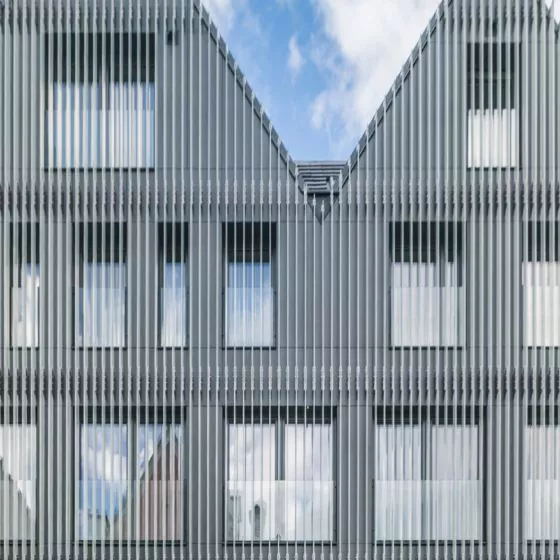Cohabitation
[original material A&B 02'2020]
Gdansk is an urban laboratory, and two strategies of creativity clash there. The first is analytical and thus profoundly modernist: it strives for the functional quality of space according to the pattern of a marten furnace: burn out the impurities you need, melt the purest ingredients perfectly. The second is synthetic and thus deeply postmodern: it strives for the cultural quality of space according to the pattern of nature: you need to achieve layering and mix, let the new rise next to the old.
With the hybrid reconstruction of the Main City, Gdansk reversed the zeitgeist of urbanism: pomodernism happened there first, and only then came modernism. First excellent public and community space was (re)built, and only then the former began to be subordinated to the functionality of transportation, and the latter was turned into parking lots. First, a truly urban utility program was built in the Main City: a mix of apartments, stores, offices, schools, kindergartens, nurseries, churches and movie theaters - and only then did they begin to build neighborhoods-districts, collective schools, shops-right-districts, offices also almost-districts. Two-story churches and multi-screen cinemas were built with the return of freedom and capitalism, although the construction of kindergartens and nurseries was forgotten then.
Today, urban pomodernism forms a brace of good urban construction: from the hybrid (re)construction of the Main City to the equally hybrid (re)construction of the Garrison in Wrzeszcz. It is noteworthy that both of these hybrids began their success by building culture: in the Main City, almost only the massive churches survived the bombing; soon after reconstruction began, in 1954, an art school was brought in from Sopot to the Great Armory, and by 1957 the iconic student club Żak was already operating. At the Garrison, (re)construction began in 2005 with the adaptation of the old buildings into the restaurants and concert hall of the Old Manege, and the café-bookstore Sztuka Wyboru. The Garrison became a good address before the first houses with apartments, stores and underground garages were built there. Importantly, the Main City and Garrison are built on precisely defined, geometric street grids that delineate closed quarters of community spaces reserved for residents.
Inside this bracket of good urban pomodernism, the marten-like structures of urban modernism are being built in Gdansk.
Spectacularly, as an extension of the Main City axis, the Forum Gdansk was created with a public space formed by shopping center buildings and completely devoid of apartments and local residents. The multi-level quasi-public space inside the buildings is as good as the space of good international airports.
Similarly, an important place in Gdansk - because between the university campus and old Oliva - has been occupied by an office supercenter with the tallest skyscraper in the city. Urban planners say that the university is its hinterland (and I would prefer the opposite). And most of all, I would like to see the Cathedral remain the tallest building in old Bishop's Oliva, and its park and surrounding city-garden merge with the university to create a truly European university town. Office marts, however, have caused the opposite situation: the university has fenced itself in - fending off office building people looking for free parking.
There is also a really important place in Gdansk's urban planning laboratory: the former shipyard sites. For years there has been a debate about them - a difficult one, because at its very beginning an urban plan was adopted, which, although it did not assume the maintenance of post-industrial urbanism, imposed neither a coherent street network nor restrictions on the height of buildings on the site. Marten's plan - though still salvageable.
I like this Gdansk laboratory, although being part of it is difficult. As in perhaps all Polish architecture, it talks too little about theory (which, after all, must be theory if it is to stay ahead of practice) and teaches too much from its mistakes. I still believe that the seed from which the local identity of Gdansk urban planning should grow is hybrid city building. It was while learning from the Main City that I described the importance of the street grid and its deformations in building the identity of urban interiors [cf. p. 102]. It was while living there that I became convinced that the essence of good architecture is its dialogicity, not expressivity. Be that as it may, I also convince my interlocutors today that Gdansk can still become a European model of a Dialogic City - and Garrison is a good sign of that.
And finally, I will tell a short story from life in the Main City. Lo and behold, I heard a key in my apartment door, jumped off my kitchen chair and ran. - Look out! - I heard my grandmother's voice behind me. The first one, almost backwards, opening the door wide, entered the mother. Followed by dad. The rounded wooden box of the TV balanced on his hands riskily held with his chin. Behind him, Mr. Skrzynecki - a handyman - with the antenna and cable in his hands. They worked late. And in the morning... what delighted me most was Mr. Skrzynecki's idea! Lo and behold, the antenna cable ("a good one, because it was coaxial, not a two-wire cable") did not go outside the window, but disappeared into the room's ventilation grill! So, it didn't absolutely hang on the outer facade of the building according to the principle of "the new has its requirements", but hid, fit in, because it understood the invisible structure of our house. It was the first dialogic gesture of architecture I had seen.














